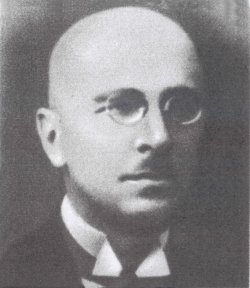
Jan Jankowski aka "Sobol"
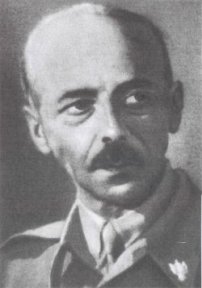
div. gen. Tadeusz Komorowski aka "Bor"
Wola Uprising 1944
In second half of July 1944, situation on eastern front, became worse for Germans. Soviet offensive, started in June, was heading to Warsaw. Tired, covered in dirt German soldiers, started to march through Warsaw on 23rd July. They marched in never-ending columns, consisted of soldiers, cars, carts and horses, from Praga district, by Kierbedz Bridge, through Modlinska Route, Poniatowski Bridge, Aleje Jerozolimskie, and further to Wolska and Grojecka streets. From direction of Radzymin, artillery was heard. Germans were retreating on the left bank of Vistula river.
German employed in Warsaw, were living the city in panic. Governor Ludwig Fischer and commissar mayor Ludwig Leist left also. Mass evacuation of German institutions and authorities started. However after few days situation started to be normal. German police, SS and some authorities including governor Fischer came back. Warsaw was too important for Germans, for just to lose it without a fight. And Vistula line had great strategic meaning.
To reinforce defense on eastern front, new troops were sent to Warsaw. They were mostly unloaded in Proszkow and Skierniewice railroad stations. Those were veteran divisions, highly experienced on western fronts. Some of them were: airborne-armored division "Hermann Goring" transported quickly by trains from Italian front, and 5th Armored Division SS "Viking". Also units defending eastern districts of city on right bank of the river were aided. Garrison forces, counting 15 000 men were reinforced by SS and police units, they all were commanded by chief of city defense, which since 31st July was 52 years old general lieutenant Reiner Stahel, trusted man of Hitler. Just two weeks before, he successfully broke through Russian forces, after five-day battle when he was retreating from Wilno. For that he was decorated with oak leafs with swords added to his Knight Cross.
Two Poland enemies were now fighting in capitol city. In diplomatic chambers of anti-Hitler coalition, negotiation took place, over various matters, one of the most important was matter of Poland. Secret, bad for Poland decisions were made already in 1943 in Teheran.
It was not until July 21, 1944 that Home Army - HA [AK - Armia Krajowa] started to consider Warsaw as a site for open fighting with Germans. Made in the end of 1943 "Burza" ("Storm") plan, was assuming helping the Soviets in fighting Nazis, but in the beginning Warsaw was not mentioned as place for confronting Germans.
However political and military situation in the end of June and July 1944, changed that completely. According to that plan: "Due to the Soviet Army which is now on our lands, we must take place of host. We must strive to achieve point were Polish commanders after fighting Germans will be hosts and welcome Soviets in that state."
Political situation was becoming more and more complicated, the day before official meeting of Prime Minister Stanislaw Mikolajczyk in Moscow, it would seem that uprising will have significant meaning, in further talks with USSR. Uprising was however completely against Stalin's plans for Poland.
Radio dépeche from Government in-exile was sent on 25th August 1944 to Government Delegate Jan Stanislaw Jankowski aka "Sobol" and General Commandant of Home Army div.gen. Tadeusz Komorowski aka "Bor": "On meeting of Government, decision and therefore resolution was made, which gives you free hand to start uprising in moment chosen by you..." And so the decision was now in hands of commanders of Home Army. They decided to fight open war with Germans. Only date was left to choose.
 Jan Jankowski aka "Sobol" |
 div. gen. Tadeusz Komorowski aka "Bor" |
First Soviet tanks reached Praga outskirts on 29th July. It have seemed that Warsaw freedom was matter of days. In the evening Polish Patriots Union, called Warsaw to fight by Moscow Radio:
"Fight against Germans!" Warsaw undoubtedly hears cannons roaring...
For Warsaw, which has never gave up, never stop fighting, time to act has come!..."
After few test mobilizations, in afternoon of 31st July, Home Army Headquarters, decided to choose date for uprising, it was called "W" hour, it was 5pm of 1st August.
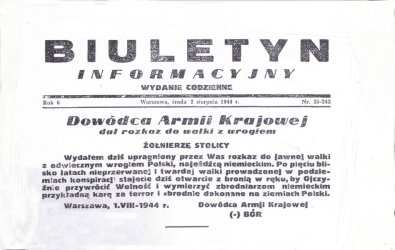
Order of Home Army Commander about Uprising
Commander for Warsaw District of HA colonel Antoni Chrusciel aka "Monter", sent order to his troops.
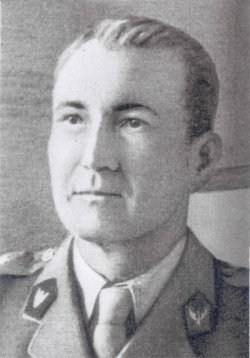
Colonel Antoni Chrusciel aka "Monter"
Tanks from "Herman Goring" division were stationed in Ulrych Gardens between Prince Janusz and Gorczewska streets. Other units were located in Bemowo, Boernerowo and Gorcow areas. Since 29 July heavy tanks were going through Aleje Jerozolimskie and Poniatowskiego Bridge, to the Praga, and further to Wolomin. Some tanks stayed in Ulrich Gardens.
Stay of German troops in Ulrichow had tragic effects for insurgents in the area. Because in the Gardens Home Army had storages for I and III Units of WOla. In effect Polish soldiers were cut off from the weapons supplies. Circa 1500 men were unarmed in the beginning of Uprising. Historians point that fact as one of the most probable for failure of Uprising in Wola.
In organization structures of HA XX District Warsaw-City, Wola was District III. Area of District Wola was divided into three smaller ones: I border with Ochota, II in the middle of District, and III border with Zoliborz.
Code name in whole district was with the initial letter "W", and numbers for units were closed in "300". Wola was commanded by major Jan Tarnowski aka "Waligora", chief of staff was lieutenant Jerzy Dominik aka "Wilnianin".
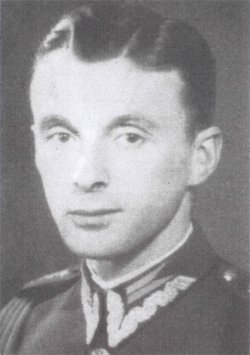 Mjr Jan Tarnowski aka "Waligora" |
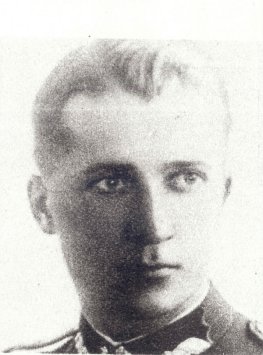 Ltn Jerzy Dominik aka "Wilnianin" |
Districts were commanded by lieutenant Stanislaw Gabrysewski aka "Balbo", captain Waclaw Stykowski aka "Hal" and by captain Stanislaw Stefanski aka "Stefan".
District I, was an area covering southern part of the district from Odolany to Czyste. Forces of this region were counting circa 700 men in 13 platoons, quite well armed. They were equipped with 11 machineguns, 80 carbines, 12 machine pistols and 150 pistols.
District II was in south bordered with District I and was narrow area placed from Jelonki along Gorczewska street, through southern part of Ulrychow, and then becoming broader covering all Mlynow. Four units were allocated here: Lieutenant's "Wit" 3 platoons, Lieutenant's "Ostoja" 2 platoons, lieutenant's "Zar" 3 platoons and lieutenant's "Gromada" 3 platoons. Overall force of insurgents were counting 700 men, armed with 5 machineguns, 52 carbines, 7 machinespistols and 160 pistols.
And the District III, was covering north-western part of Wola, including Gorce, part of Ulrychow and Kolo. Area forces were assumed to be circa 1000 men after the mobilization. However they were completely unnarmed, they had only 4 submachine guns and some grenades. Because the plan was to equip all the men with the arms storage in warehouses, after the mobilization is done.
Overall District was counting force of 2600 soldiers armed with 2 heavy machineguns, 16 assault machineguns, 132 carbines, 23 submachine guns, 310 pistols and around 1000 hand grenades.
In addition to that in the eastern part of Wola along Okopowa street was placed gather point for soldiers from Kedyw, from unit "Radoslaw".
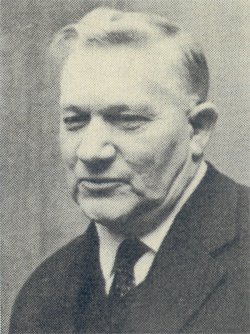 Lieutenant colonel Jan Mazurkiewicz aka "Radoslaw" |
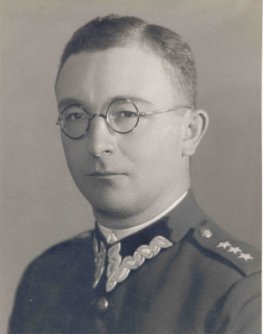 mjr dypl. Wac³aw Janaszek ps. "Bolek" |
Those were elite Home Army units: battalions "Parasol", "Czata 49", "Zoska", "Piesc", "Miotla", armored platoon "Wacek", Kolegium A Unit, Women Unit "Dysk". Units were commanded by lieutenant colonel Jan Mazurkiewicz aka "Radoslaw", chief of staff, and second commander was major Waclaw Janaszek aka "Bolek". Aims of Kedyw was to defend Home Army Headquarters, placed in Kamler factory on Dzielna street 72. These units could be used also as reinforces for units of Wola District. Unfortunately plans in District did not allow them to fight alongside the forces of Wola soldiers.
Also in the area was stationed 3rd battalion OW PPS under captain Karol Krynski, and platoon of People's Army commanded by sub-lieutenant Zbigniew Paszkowski aka "Stach".
Germans had in Wola over 4000 tankers, grenadiers from armored division "Herman Goring", pilots from Boernerovo, Wehrmacht and SS troops, supported by Bahnschutz (railroad guards) and Werkschutz (factory guards). They were extremely well equipped, and supported by tanks and artillery.
What is more, late orders, effected in slow mobilization. German troops located in Bemowo, Boernerowo, Gorce and in Ulrychow, were going to the western front, they have jammed main roads, and what is worse supply and arms magazines for District I of Wola, placed in Ulrych Gardens.
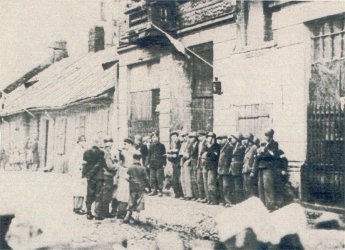 |
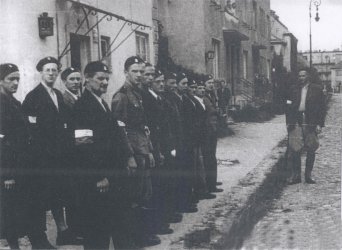 |
Assembly of HA units during "W" Hour.
In district I in gather points only 20% of soldiers came, in District II 80% and in District III 17%. Overall in whole Wola were circa 950 soldiers from HA, circa 100 OW PPS [Military Organization of Polish Socialist Party], and about 20 from PA - Public Army [Armia Ludowa - comunist organization]. Due to the communication problems, only small number of arms was delivered. In effect only part of insurgents had guns. Such problems had unit "Radoslaw", it had circa 900 men in the beginning.
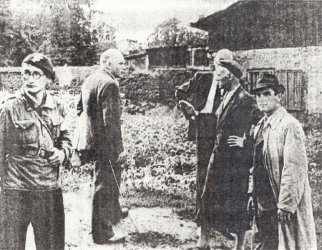 |
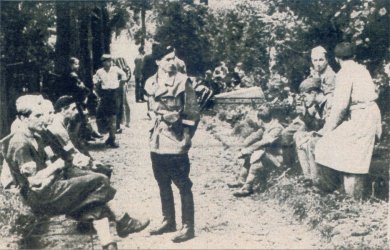 |
Gathering of soldiers near protestant cemetery, these are men from battalion "Piesc" (Fist), from Radoslaw unit.
But the objectives for Wola were great. For example one of the objects was to take over tracks of circumference railroad, which was splitting Wola in two, that would stop armored train operating in the area. In plans was also taking over of barracks, pilots school in Boermerowo, petrol warehouse "Naftusia" in Ostrorog, Railroad Station, Bem's Fort, school on Ozarowska street, Deotyma and railroad workshops on Sokolowska street. These tasks were far too much for Wola forces.
1 September 1944, at 2pm o'clock, in Headquarters of District on street Dzialdowska 7, meeting of commanders started. Some of them said that due to the bad results of mobilization no action should be taken at that time. However voices saying that objects for Wola should be achieved mostly by forces of D II won.
Just before the official beginning of Uprising, fights started, Czeslawa Janowska, was living on Swoinskiego street at that time, she was witness of these actions:
"Around 2.30 pm on Wolska near Sowinskiego, two armed men leaped from car that was stopped by Wehrmacht. Shootout started. Two men escaped and hid in the nearby buildings. The rest of the people in the car escaped in it. Panic started in the street. Frightened people were throwing themselves to the ground. Germans quickly called reinforces. In revenge they captured eight men, which were next killed on the crossroads of Sowinskiego and Karlinskiego streets."
The woman saw the stopping of the car and the execution. In order to get home she had to get by narrow passage just next to the killed men.
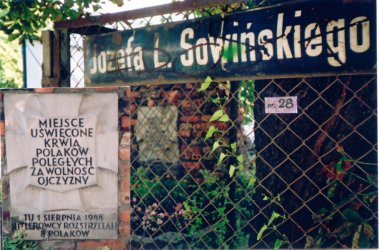
Plaque, on Sowinskiego 28 (fot. J. Mankowska)
After that incident germans immediately, allocated heavy machinegun on the rooftop of building on Wolska 174, in order to have a clean shot on the streets in the area.
Another fight took place near Okopowa street, just next to the cemeteries, during the delivery of weapons to the "Radoslaw" unit. Shootout emerged in furniture factory "Kamler" on Dzielna street, when Germans came to take transport of uniforms, from warehouse placed there. This action alarmed police. As said before the Headquarters of Home Army were placed in this factory, in effect it was cut off for several hours. Quick reaction unit of German police, came with 3 cars supported with armored car. The noise of fight also caught attention of chiefs from "Radoslaw" unit, they were residing in building on Okopowa 44. And in effect Kedyw unit attacked police. Insurgents won, and took to custody several officers , and captured some weapons and ammunition. Unfortunately armored car broke through to Gorczewska street, and successfully informed soldiers stationed in Ulrychow about whole situation. When Poles begin uprising, Germans already new about it.
Unit of lieutenant "Ostoja" suffered that painfully, while they were fighting on Ksiecia Janusza street. Before insurgents started real fight, they were already attacked by tanks and infantry, concentrated in Ulrychow. After an hour of bloody fight (to 6pm), unit was defeated, Germas were killing wounded and prisoners.
Similar fate was faced by unit of lieutenant "Gromada", while they were preparing attack on german soldiers stationed in schools on Ozarowska near Deotymy street and on Zawiszy street. Polish attack was biased by German tanks and infantry troops. Unit was defeated, loses were nearly 30%. Again Wehrmacht was killing wounded and captured Poles. Few were saved just before execution by unit of People's Army, commanded by sub-lieutenant Paszkowski, he was retreating to Obozowa and further to Mlynarska street.
Another failure was when lieutenant's "Wit" unit was attacking fuels storages "Naftusia" on Wawrzyszewska street. Attacking Poles were stopped by fierce fire from heavy machineguns. They have not lost as many people as others but they were unable to fulfill their duties.
Lieutenant's "Zar" unit, partially achieved their goals, they have captured school on Gostynska street. However the railroad workshops were still in German hands.
Fully successful were only units from "Radoslaw", which were operating behind forces of Wola District. These battalions captured whole north side of Okopowa and buildings on west and east side of the street. Battalion "Zoska" assaulted Saint Jadwiga school (in that time German barracks were located there) on Okopowa 55a, they captured soldiers located there and captured some weapons. Also, they have taken factory on Pfeiffer street near Okopowa 58/72 and Jewish cemetery. Platoons from battalion "Parasol", took over Calvinistic cemetery and entered Mlynarska street near Gorczewska and Wolska. "Miotla" battalion took positions on crossroads on Okopowa, and on Kercelego Square. Lieutenant's Stanislaw Sosabowski aka "Stasinka" captured warehouse that belonged to "Bacutil" factory on Stawki 4, it held supplies of food and German uniforms.
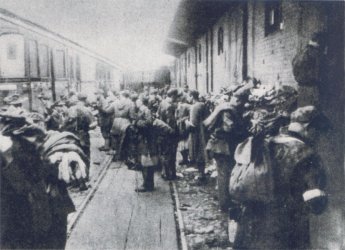
Warehouses on Stawki, taken over by units from "Radoslaw"
Another school on Niska street was captured, insurgents freed around 100 Hungarian Jews prisoners, in addition they obtained some carbines along with ammunition.
During the fights on Obozowa street, unit of People's Army under commandment of lieutenant Zbigniew Paszkowski aka "Stach", came to help Home Army. This unit of PA took part in assault, just like another unit under sergeant major Lech Matawski aka "Mirek", which was assisting in attacking the main trams garage on Mlynarska.
German forces were counted for about 30 tanks and many soldiers. Overpasses of circumference railroad were heavily defended by Nazis. Tanks were shooting even without reason while patrolling streets.
Heinrich Himmler was informed about Uprising in Warsaw just 30 minutes after it began. He told Hitler that he wish to take part in fighting the Poles. He said:
"Mein Furher, historically this is a blessing. After five or six weeks we will be clean, and Warsaw, the capitol, head and intelligentsia of this nation will be lost."
Hitler in his rage ordered to withdraw all troops from Warsaw and to bombard whole city with forces of 6th Air Fleet commanded by general Ritter von Greim. However this cannot be done. And so he ordered Himmler and Guderian to bring aid, for trapped in Warsaw German troops. He said: "Warschau wird glattrasiert" - "Warsaw must be razed to the ground".
Himmler sent telegram to commandant of concentration camp in Sachsenhausen near Berlin, with order to kill general Grot-Rowecki which was kept there. Himmler left Ketrzyn in Western Prussia, and flew to Poznan, where he started to organize reinforces for Nazis troops in Warsaw.
On 1st August Hitler and Himmler issued a joint command: "Every citizen must be killed, do not take prisoners. Warsaw must be razed to the ground, and so it will be a terrifying example for the rest of Europe."
During the night from 1st to 2nd August lieutenant colonel "Radoslaw", won battle with Germans menacing Home Army Headquarters, and was successful in freeing commanders.
Just after 5pm commander of SS and police for Warsaw District general Geibel, contacted by telephone with cut off in another part of the city commandant of German garrison general Reiner Stahel. General Stahel sent by telephone and by radio, requests for reinforcements to the governor Hans Frank in Cracow, and to the headquarters of 9th Army. On 1st August around 11pm, began consultations in headquarters of 9th Army in Skierniewice, with commander of armored forces general Nicolas von Bormann, it has lasted until dawn.
During the night from 1st to 2nd August insurgents built famous barricades that closed the entry to the city. Dense web of barrickades was built on Wolska and Gorczewska and their cross streets, beginning from Plocka street to Kercelego Square.
People used all they could to build these obstacles: trams, cars, horse carts, flagstones, bricks, rails, sacks with sand, furniture, and soil. Addition to the barricades, were anti-tank trenches and communicational ones.
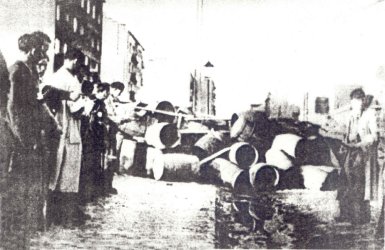 Barricade on crossroads of Mlynarska and Zytnia streets. |
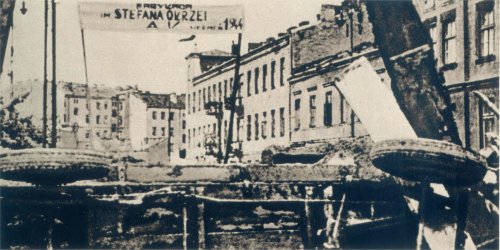 Barricade on Okopowa near Zytnia. |
Civilians took great role in building obstacles. Some of them were more than 2,5 meters high, anti-tank ditches and trenches were 3,5 meters wide and 1,8 deep.
The barricade on crossroads of Mlynarska and Wolska, constructed from trams was able to stop the heaviest tanks.
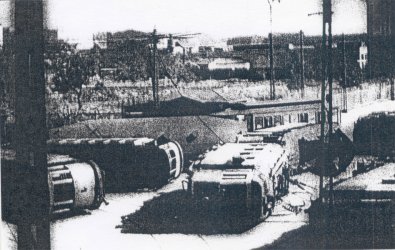 |
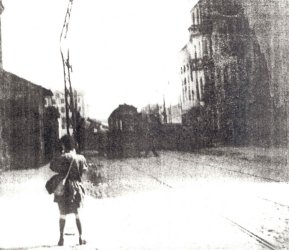 |
Barricade on crossroads of Mlynarska and Wolska.
Main goal for Nazis was to clean the roads in west-east direction, mainly bridges: Poniatowski and Kierbedz, in order to keep supply routes for troops on the other side of Vistula. Another task was to free, soldiers surrounded in Bruhl Palace, also commandant of Warsaw garrison general Stahel and governor of Warsaw District Ludwig Fischer was trapped there.
Due to that situation, strong German assault started in two districts: Wola and Ochota, which were Warsaw western shields.
Since morning of August 2nd, German attacks began on Polish positions. Main assault was on Wolska and Gorczewska streets. Also Germans were attacking from north from Powazkowska to Okopowa street, in order to capture cemeteries. First strike from west took place around 7 am, Nazis were stopped on barricades in Plocka street. German troops attacking along Wawrzyszewska, pushed insurgents to positions on crossroads of Mlynarska and Ostroroga.
Another attack started around 7.30 am, from Powazkowska and Okopowa. This time also tanks and armored transporters took part in action. Units of sublieutenant "Radoslaw", stopped Nazis, captured some prisoners as well as a lot of equipment.
Germans, started another attack around 11 am, along Wolska and Gorczewska, infantry was reinforced by tanks and fire from howitzers, they managed to assault insurgents positions on Plocka and Gorczewska. Sub units under commandment of captain "Hal" were forced to retreat to barricades on Dzialdowska, and later to Tyszkiewicza street, partially even to main obstacle in the west on Mlynarska street.
Situation on Wolska was similar. Despite the fierce defense on Plocka, Dzialdowska and Skierniewicka Germans were getting forward, and capturing new points in houses on left and right side of the Wolska street. Assault reached barricade on crossroads of Wolska and Mlynarska. This point was heavily defended mainly by units from Home Army under captain Waclaw Stykowski aka "Hal", and captain Karol Krynski aka "Waga" from units of Military Units of Uprising Readiness of Socialists, also PA units under sergeant major "Mirek" and sublieutenant "Stach"were helping. German attack was stopped.
From Lutheran cemetery, few Polish patrols were sent, to investigate situation in Wolska and Gorczewska. Around 4 pm, sub units from battalions "Czata 49" and "Piesc", attacked from cemetery on north wing of German forces. This effected in German retreat to Plocka street, it greatly helped in situation on barricades on Mlynarska, Gorczewska and Wolska. This area became peaceful for a while.
However Germans still attacked north parts of District from Powazki cemetery along Okopowa street. Ahead of tanks around 50 Poles were forced to serve as "living shields". Despite that German attack was stopped in Powazki Cemetery, with forces of su unit "Broda" from "Radoslaw" unit. Soldiers from battalion "Zoska" captured two "Panther" tanks, which were repaired by mechanic Jan Luniewski aka "Lubenski". He was first to be decorated during the Uprising with Silver Cross of Merit with Swords. Tanks were later used in fights.
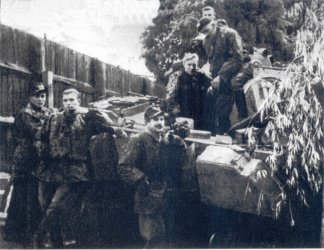 |
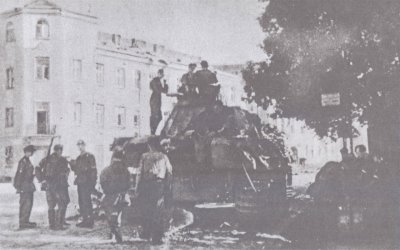 |
German tanks captured by soldiers from "Radoslaw" units.
In the evening, by order of sub-lieutenant "Radoslaw" positions on crossroads of Ostrorog and Mlynarska were taken by his forces. Smaller units were able to reinforce defense on barricades on Zytnia, Gorczewska and Wolska streets. During the night from 2nd to 3rd August units defending barricades along Mlynarska near Wolska and Gorczewska sent small insurance units to the west direction. Michler Mill and line of streets (Dzialdowska and Staszica) was taken. Patrols found that Germans during the first two days commit mass murders on civilians on Wolska, Gorczewska and Sokolwska, and near Powazki, on Powazkowska 41.
Heinrich Himmler started to organize forces to help soldiers in Warsaw. He ordered to form police force as well as military and SS, they were meant to be sent immediately to Warsaw. Commandment over these forces was given to general Heinz Reinefarth. Also SS unit was sent under commandment of SS-Oberfuhrer Oskar Dirlewanger, it consisted of criminal offenders, other unit was collaboration brigade called RONA (Russkaja Oswoboditielnaja Narodnaja Armija), with SS general Mieczyslaw Kaminski, he was renegade and traitor.
All units reached Warsaw on 3rd and 4th of August, they were allocated on Ochota (Kaminski brigade), and on Wola (Reinefarth group with Dirlenwanger brigade).
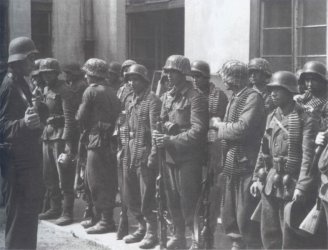
Men from Azerbaijan in Kampfgruppe Reinefarth.
Commander of all German forces in Warsaw was S-Obergruppenfuhrer general Erich von dem Bach, previously he was commanding units for fighting partisan groups that were disturbing Wehrmacht actions.
On 3rd August at 8 am, infantry supported by tanks began attack along streets Gorczewska and Wolska. Nazis used civilian people as a shelter for tanks and for dismantling barricades. Morning attack was repelled successfully thanks to special units created for fighting armored brigades, they were using incendiary liquid to burn tanks.
At 10.30 am Germans attacked again mainly along Wolska street. And again hundreds of Warsaw people were used as living shields. Big group of tanks and infantry reached main barricade on crossroads of Mlynarska and Wolska. Due to the heavy attacks defenders retreated to Mlynarska street, partially to trams garage. Civilians were made to create a passage for tanks in the barricade. Armored column made of division "Hermann Goring" after breacking the barricade, went to Towarowa street then to Alleje Jerozolimskie and Poniatowski Bridge, and finally reached Praga.
Infantry began to destroying points of resistance on Mlynarska street. Heavy fights started especially over houses with numbers 12, 14 and 16. After heavy battle platoon from PA (sergeant major "Mirek" unit) along with platoon from "Parasol", were successful in capturing back whole Mlynarska from Gorczewska to Wolska, and units from OW PPS under captain "Waga" from side of trams garages. captains "Waga" and sergeant majors "Mirek" took again positions on barricades on crossroads of Mlynarska and Wolska. Soldiers were also successful in freeing people from houses placed further away. In the evening barricade was rebuilt and fully stationed by insurgents again. In recaptured houses, soldiers found murdered people. German planes dropped leaflets, which were convincing to stop the fighting.
4th August was turning point for Wola. On this day new German forces came from Poznan, these were SS and Wehrmacht units, police brigades "Warthegau", unit SS "Dirlenwager" and others, all under commandment of general Reinefarth. Generals Reinefarth and Dirlewanger received orders from headquarters of 9th Army to start the attack on 5th August in line Wolska-Chlodna-Sas Gardens-Bruhl Palace.
From morning Germans were continuously attacking Polish positions on Wolska and Gorczewska. After fire from howitzers, patrols were sent, they had to retreat after they were attacked by insurgents. Diving bombers were sent three times on that day, around 30 planes were dropping incendiary bombs on area along Wolska, Gorczewska and Mlynarska streets. After bombing, German attacked again in four directions: Wolska, Gorczewska, Zytnia and Dlugosza streets. However attacks came to nothing due to the heavy fire from Poles. Small groups from "Radoslaw" unit were attacking german police stationed in ghetto. They were attaking mainly in the afternoon and in the early evening along Zelazna street.
Hospitals in Wola especially, Wlski Hospital (Plocka 26) and Karol and Maria Hospital (Leszno 126), were receiving huge numbers of wounded people. Insurgents that were captured by Germans and civilians from area controlled by Nazis were mostly killed.
During the night from 4 to 5 August around 1.00am insurgents received help, dropped on parachutes weapons and ammunition. Previously announced by radio plane "Halifax" dropped their load on cemeteries, on Jewish and Powazki, and near Mlynarska street. That was first help that Warsaw received by air from West.
5th August brought another attack. At 7.00 am units commanded by gen. Reinefarth supported by Dirlewanger began assault along streets: Siedmiogrodzka, Kalinki, Wolska, Gorczewska, Zytnia and Dlugosza. Artillery, heavy machineguns, heavy tanks and bombardment was used.
Barricade on Gorczewska near Dzialdowska was lined with soldiers from lieutenants "Zara" unit, obstacles on Wolska and Mlynarska by platoon from PA and units from OW PPS, on Gorczewska and Tyszkiewicza by ensigns "Jasmin" unit. On Gibalskiego was allocated unit "Stefan" it was reinforce for majors "Waligora" unit. "Radoslaw" was stationed in Ostroroga and Mlynarska, Leszna and Mlynarska, Zytnia and Mlynarska, and in few points on east side.
Right wing of German assault was formed by Dirlewanger battalion, center by Reinfarth units with heavy tanks, left wing consisted of German garrison from Wola. Germans gathered 3000 soldiers on front that was only 1 kilometer wide. Assault was supported by artillery and tanks, howitzers and heavy machine guns placed on towers of saint Wojciech church and guard towers of "Naftusia". Strikes of infantry were preceded by bombardment mainly on barricades and cemeteries.
After planes, infantry began attack supported by tanks. On Gorczewska street armored train gave additional fire support. He was using circumference railroad.
Main forces were attacking Wolska. Assault groups were preceded by three heavy tanks that were shooting with guns and machineguns in order to destroy resistance points in building along the street. Near Michler Mill, where was situated one of the insurgent points filled with men from "Parasol" and platoon from PA, one of the soldiers from People's Army destroyed German tank.
Thanks to the night drops, insurgents were armored heavier. And so they were able to stop the Germans on barricade on Wolska and Mlynarska. Nazis were more successful on Gorczewska, fire from armored train destroyed barricade on Plocka and Dzialdowska. Around 10.30 am, bled unit "Zar" was forced to retreat to barricade on Tyszkiewicza street. In captured houses Germans started to kill civilians and burn their homes.
On Wolska 40, assault group from I Company of battalion "Parasol", under commandment of sub-lieutenant Janusz Brochwicz-Lewinski aka "Gryf", was in heavy fight over Michler Palace. One of the soldiers, fighting on that day was cadet sergeant Jozef Szczepanski aka "Ziutek", he wrote famous song "Michl Palace".
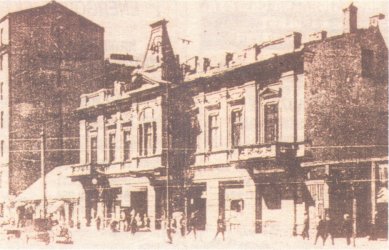 Michler Palace |
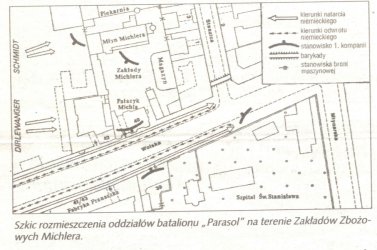 Stations of "Parasol" soldiers |
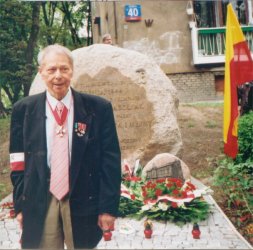
Jan Brochwicz-Lewinski by plaque. (photo by J. Mankowska)
Later heavy fights started near trams garages. Germans took attempt to go around the barricade, and attack from south, unit from OW PPS was destroyed and commander captain Krynski was killed. Saint Stanislaw hospital was taken over by Germans, and around 2.00pm barricade on Wolska and Mlynarska was attacked from behind (east and south) and destroyed.
Units of Wola District retreated to barricades on line of street Mlynarska and Gibalskiego, near Lutheran cemetery. Commander major Tarnowski was wounded and unable to command, so he was replaced by chief of staff Jerzy Dominiuk "Wilnianin". He calmed down the situation. Insurgent recaptured Karol and Maria Hospital, and were preparing to defend crossroads of Gibalskiego and Zytnia. Commandment of assault forces was given to captain Waclaw Stykowski "Hal". People's Army platoons from barrickade on Wolska and Mlynarska retrated to Ogrodowa street. And along with lieutenants "Ostoja" unit they began to organize defense. Around 5.00pm, situation was stabilized, German assault was weaken, and unable to cross Gorczewska and on west side Mlynarska street.
Around 6.00pm west from Lutheran cemetery into direction of Wolska street, counter attack of "Radoslaw" units began. In counter attack took part units from battalions "Parasol", "Czata 49", "Piesc" and captains "Hal" unit. Unfortunately Polish attack was stopped near Wawelberg and on Gorczewska near saint Lazarus Hospital. Despite that attack prevented Germans from moving forward, and gave time to evacuate civilians. At midnight Karol and Maria Hospital was ordered to evacuate.
In the ghetto battalion "Zoska", with support of two tanks captured at 5.00pm concentration camp on Gesia street. Around 350 Jews were freed, most of them were from foreign countries: Romania, Hungary, Czech, Netherlands and others (24 of them were women). These Jews were evacuated with Warsaw civilians to Old Town.
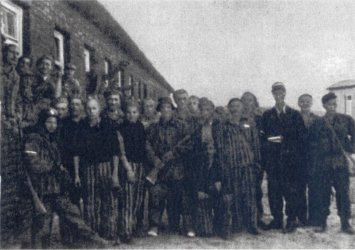 |
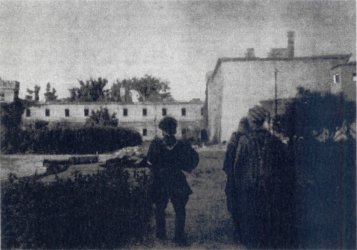 |
Soldiers from "Zoska" in Gesiowka
Once more innocent people were used by Germans as living shields, this time in the south. Witness of that Alicja Bajdasiuk:
"Swelter from sun, and from burning buildings was unbearable... From Kercelego Square, our soldiers were firing to Towarowa direction. Germans captured us and used as "living shield".
They ordered us to spread from one side of the street to another, if not they would kill us. We were knelling with our faces toward Germans, while they lie down before us or kneel on one knee and shoot through us in direction of Kercelego Square.
There were 23 of us, including 2 children. It is hard to tell what we faced during two hours of this action. We were all prepared to die, and prey rosary aloud. Bullets were flying all over, near our heads, our ears, between us. Because of noise of German carbines deaf totally we were waiting for death..."
Despite the heroic defense of Kercelego Square Germans captured it on 5th August in the evening. Around 7.00pm gen. von dem Bach came to Wola, he's hedquarters were created in Sochaczew.
From dawn mass murders of innocent people began in Wola, as well as burning their property. During Saturday 5th August nearly 20 000 people were killed in Wola.
During the night from 5th to 6th August, forces of Uprising reorganized. Main force from District II, that is captain's "Hal" unit counting 140 men, retreated to Krochmalna street, and merged with captain's "Sosna" unit. Some platoons from I and II District came to Ogrodowa street and merged with forces from Downtown. Platoons from District III merged with "Radoslaw" unit. In that situation, defending the rest of remaining pieces of Wola was given to "Radoslaw".
Germans launched assault next at 6.00am, through Kercelego Square in order to reach deeper into the city. Dirlewanger battalion after heavy fights broke through along Chlodna and Elektoralna streets to direction of Zelazna Brama (Iron Gate). In the afternoon German reached Mirowskie's Halls, and make they way through Saski Garden to Bruhl Palace. General Stahel and governor Fischer were most pleased to see aid, because unit that was defending the Palace was nearly defeated.
On Wronia street, fights were lasting till late night hours, PA units that retreated from Wola, were given new commander major "Ryszard" he came with reinforces from Downtown.
German were trying to clean and make safe east-west routes, and to defend them from south and north, so they lunched attack from south from Wolska street on distance from Okopowa to Mlynarska, and from west from Plocka along Dlugosza and Zytnia. Concentrated attack was supported by tanks and howitzers.
In the beginning insurgent were holding positions on Gorczewska and Zytnia. Direct assault on cemeteries began at 2.00 pm, from Zytnia and Mlynarska. Lutheran cemetery was crawling with Nazi assault units. Two hours later Poles had to retreat from cemetery to Okopowa.
In order to recapture lost positions, around 6.00pm was lunched Polish attack, from Jewish cemetery. In counterattack platoons from "Zoska" battalion were taking part. Attack was supported by fire from Okopowa, and in effect both lost cemeteries were again in Polish hands. Germans retreated to Zytnia and Mlynarska, leaving lot of equipment on the battlefield. Area on west, along Mlynarska to Zytnia street was stationed by platoons from "Piesc" and "Parasol", along Zytnia and Leszno by "Czata 49". And in the east by "Miotla". North area from barricade on Soltyka street through Jewish cemetery to Okopowa was filled with soldiers from "Broda".
Around 3.00pm Germans took over Karol and Maria Hospital, part of the staff was killed as well as wounded people, rest of them were made to march along Korczewska street to Wolski Hospital. Wolski Hospital, was taking (until 24th October) wounded soldiers and civilians from other parts and districts of Warsaw. Then they were sending to halting place in saint Wojciech church, and further sent to camp in Pruszkow.
During the capture of Wola by forces of Reinefarth and Dirlewanger, massacres on innocent people continued.
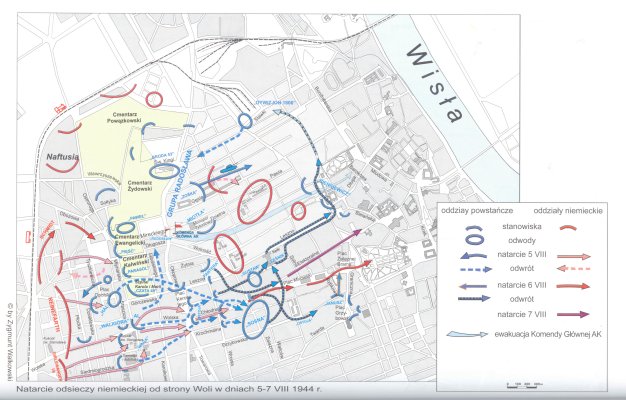
Situation in Wola from 5th to 7th August.
In the afternoon gen. Reinefarth, came in tank to Wola, and started preparations to secure captured routes.
From the morning of 7th August, gen. Reinefarth was continuing assault on Wola, "cleaning" area along Chlodna, Ogrodowa, Mirowski Square, Mirowskie's Halls and Zelazna Brama Square. Mass executions on cillians were continued on Chlodna and Elektoralna street, and in Mirowskie's Halls.
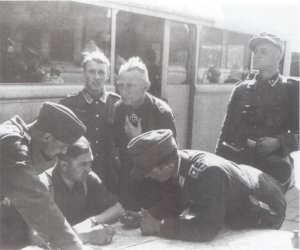
Gen. Reinefarth by his command car.
Polish counterattack near Mirowski Square, commanded by mayor Stanislaw Steczkowski aka "Zagonczyk", brought some success and cost losses in men on German side, however in the end it was pushed back to Grzybowska street.
Soldiers from "Radoslaw" units fought heavy battle over Calvinistic cemetery ("Parasol") and over stations in ghetto ("Zoska"). Biggest success of the day from Germans was cutting off area of cemeteries and Old Town from Downtown.
On 8th August German pressing started to be heavier in area of cemeteries from side of Wolska street. Reinefarth units, supported by few tanks, were pushing forward from south along Okopowa and Karolkowa. From west, German assault groups were approaching cemeteries on Dlugosz and Soltyk streets. They were also supported by armored train. Group under commandment of cadet Andrzej Sowinski, organized raid in order to destroy this train. Unfortunately raid was a failure, and Poles lost 6 men.
Around 10 o'clock Germans reached line of Zytnia street from south, and from north-west crossroads of Mlynarska and Ostroroga. Through all day lasted heavy fights between Germans and units from "Radoslaw". After seven hours of murderous struggle sub-units from battalions "Piesc" and "Parasol" left southern parts of cemeteries near Zytnia line and retreated to line of Mareckiego street. They were holding positions there until 7 pm, but eventually had to retreat under much bigger German forces assault.
Just before 8 pm "Zoska" battalion launched counterattack from Spokojna street, and pushed back Germans in effect. Defense stations in cemeteries were in Polish hands again. After Nazis broke defense on Zytnia street, insurgents made new positions in school on Okopowa 55a, and in Pfeiffer's tannery. Mayor "Waligora", and captain Adam Borys "Plug" commander of "Parasol" were heavily wounded.During the night, blooded battalion "Czata49" is relocated from Karolkowa to Stawki.
During August 9, units from "Radoslaw", in number of over 1000 well armed but very tired men were holding positions in Powazki and therefore access to Old Town. Battalion "Parasol", was relocated to ghetto, on distance from Palace of Mostowskich to line of Gesia street. Stawki were passing from hand to hand. Governor of Warsaw District Ludwig Bruhl, escaped along with his staff from the city in a tank. On Zelazna Brama Square and on Chlodna street, Germans were attacked by insurgents. Fischer was wounded and his deputy doctor Hummel was killed.
August 10 brought Nazis attacks along Okopowa, Temler's tannery and on school on Spokojna street. Despite the heavy attacks few times over day "Radoslaw" group hold stations on Okopowa, on Jewish cemetery and on Stawki.
Armored train artillery was constantly shooting into area of ghetto and Old Town. After Poles pushed back all German attacks they stopped all actions for the night.
However Nazis collected huge forces on August 11, and marched on Polish positions from south, west and north. On 4 am, they have captured insurgents positions on crossroads of Ostroroga and Mlynarska, and later north part of Powazki cemetery.
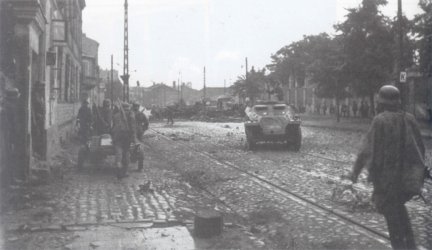 |
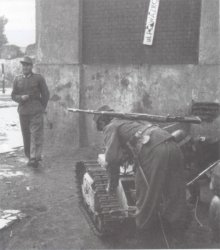 |
German attack from Powazkowska street.
Insurgent were made to defend from all directions, in school on Okopowa 55 (called Stronghold). To 4pm Poles successfully repelled several attacks.
Due to the situation in Stawki and on other sections, Polish platoons under cover of special groups from "Zoska" battalion were slowly retreating from Wola. Till evening - after heavy losses units finally retreated to Stawki. Commander of "Miotla" captain Franciszek Wladyslaw Mazurkiewicz aka "Niebora" was killed and lieutenant colonel "Radoslaw" was wounded. On August 11 whole Wola was in Germans hands.
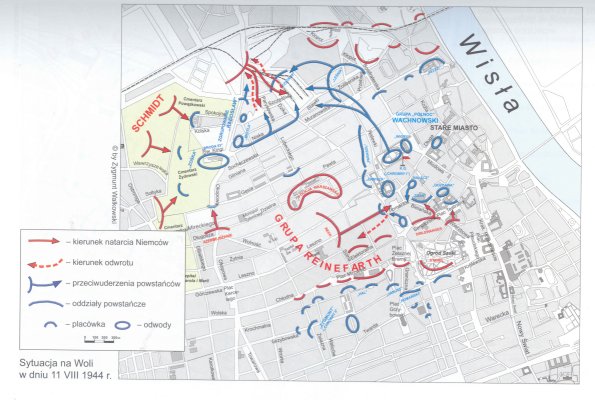
Sitation on wola during Agust 11.
Fights in Stawki, where building where going from hands to hands, stopped Germans attack just before the Old Town, and gave time to reorganize defense in Old Town, as well as chance for insurgents from Wola to retreat.
After capturing Wola, Germans, planted in Sowinski Park heaviest self-proppeled mortar in that time called "Karl", it started to bombard Old Town and Downtown of Warsaw since 15 August. Mortar used shells of 600mm caliber, 2100mm high and of weight of 2200 kg.
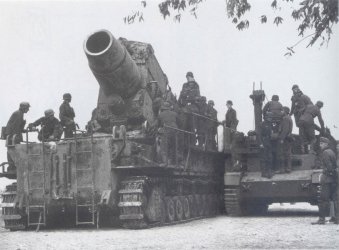 |
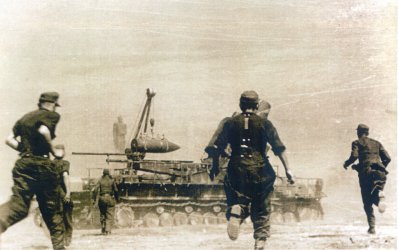 |
Mortar "Karl", on battle station in Sowinski Park.
Shell from Karl usually exploded on ground floor of tenement house, causing it to collapse and burying of cellars. One of the shells hit home on street Moniuszki 8, where famous "Adria" restaurant was placed. Bullet went through all ceilings and fell into cellar where it suppose to explode but it... did not. And so it was dismantled by Polish pyrotechnists, and explosives were used to make grenades for insurgents. Other bullet hit tallest in that time building in Warsaw - Prudential Hotel. Moment of hit and explosion was photographed by Sylwester Braun aka "Kris".
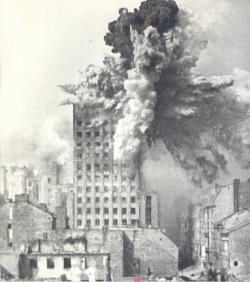
Prudential in the moment of hit by shell from Karl.
Lot of shells from Karl did not exploded. It was like that because, they were made for destroying concrete bunkers, and walls of regular houses, made of bricks were to "soft" to ignite the detonator. However there was another factor. These shells were made by people from countries attacked by Germans, and working in their factories, the production of equipment was often sabotaged.
During the fights in Wola two churches played very important role.
Church of saint Lawrence, placed on Redoubt 56, had important task in plans of Uprising.
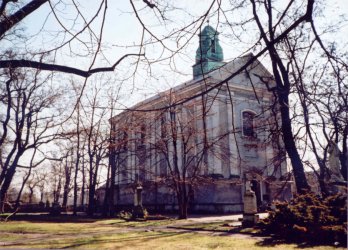
Saint Lawrence church in Wola (photo by J. Mankowska).
Parsonage was actually the headquarters of Home Army in this district. It was preparing to support airborne brigade (1st Independent Parachute Brigade under commandment of general Sosabowski), that supposed to be dropped here to help the insurgents, but... it was sent to Arnhem...
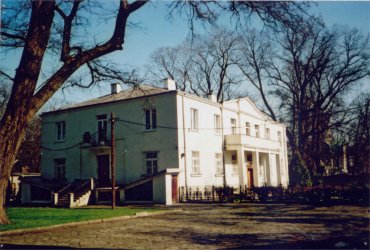
Parsonage of saint Lawrence church (photo J. Mankowska)
Polish commando never landed here, and the church became site for another tragedy. On 5th August 1944, Nazis killed 40 Home Army soldiers here, including priest captain Mieczyslaw Krygier.
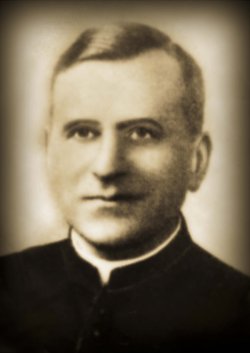 |
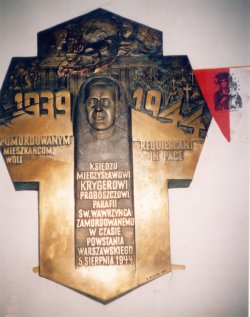 |
Priest captain Mieczyslaw Krygier and a plaque to his memory (photo by J. Mankowska)
Later Germans commit mass murders in the area of church's cemetery.
After that massacre , Nazis captured police station on Wolska 147, policemen there were helping the Home Army. Witness Waclaw Piorkowski testified:
"... On 5th August 1944, in a ditch in the Orthodox cemetery Germans shot 16 policemen and 2 civilians (they were taken from XXII Police Station on Wola). Bodies were later exhumed by Polish Red Cross, my father Wladyslaw Piorkowski was among them. Police station was well organized cell of Home Army. Priest Krygier, that was hiding wounded insurgents in the church of saint Lawrence, phoned to call for help from police... Probably Germans, tracked that call, and prepared ambush, all police officers were captured while they were living their station. They were all killed afterwards."
Church of saint Wojciech on Wolska 76 was partially destroyed in 1939. During the Warsaw Uprising Germans made a transit-camp in it for civilians evacuated from Warsaw.
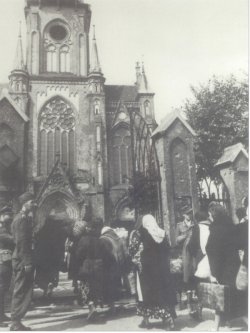
Church of saint Wojciech in Wola.
They have made the church area place for mass executions, bodies were later burned on Sokolowska 5. Camp was intact from first days of August till the end of Uprising. People from Warsaw were transported to Proszkow from here.
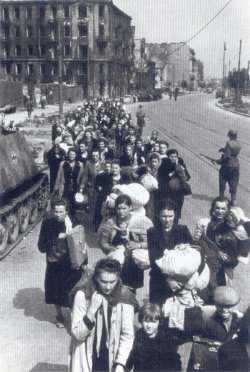
Civilians are marching through Wolska street into the camp in Proszkow.
After falling of Wola, Germans captured vital line Wola - Saski Garden - Krakowskie Przedmiescie - Kierbedz Bridge, insurgents were concentrated in three big areas, but loosely connected with each other. Those were: Downtown (with Powisle and Czerniakow), Mokotow and Old Town along with Zoliborz and Kampinos Forest.
After retreating from Wola, Warsaw insurgents were fighiting Germans for next few weeks. Capitulation was on October 2 1944, after 63 days of constant battle. After insurgents and civilians left the city, Germans started constant deterioration of Warsaw. I was not until 17 January 1944 that Russian forces and 1st Polish Army entered the abandoned and totally destroyed city.
To commemorate the defeating Poles in Warsaw during the Uprising in 1944 Germans established new badge called "Warshauer Schield", it is said that it was designed by Adolf Hitler. Badge was given to all soldiers that fought in Warsaw, it was placed on the left sleeve of uniform. Main authors of this "success" were decorated by Himmler himself with highest Nazi medals. SS-Gruppenfurher Heine Reinefarth was ordered for "bravery and war merit" with oak leaves to his Knight Cross.
compiled by:
Maciej Janaszek-Seydlitz
Jerzy Janowski
Janina Mankowska
translation: Kamil Kornatka
Copyright © 2010 Maciej Janaszek-Seydlitz. All rights reserved.